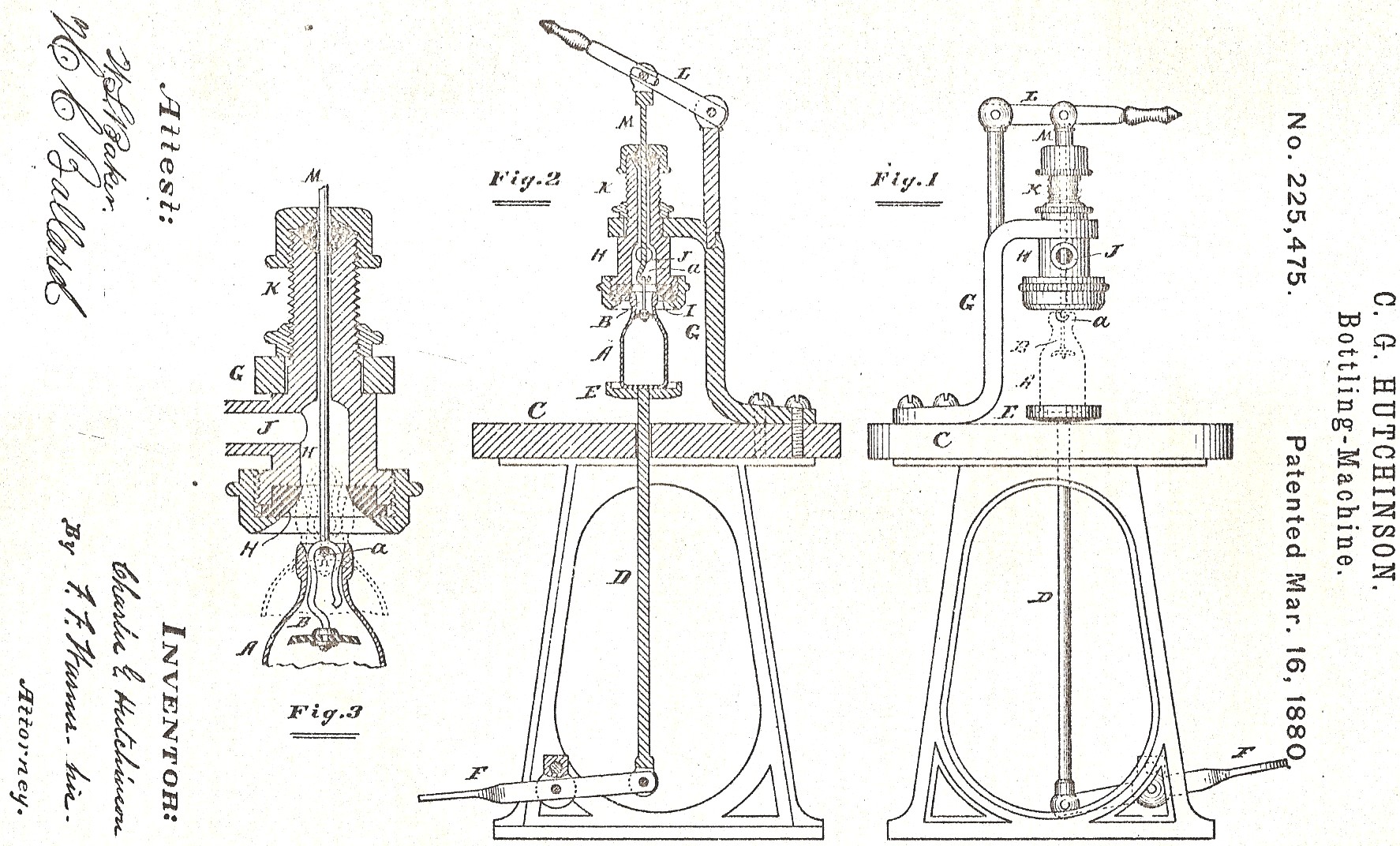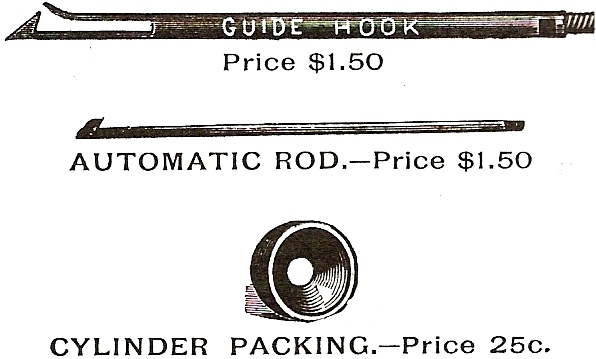Hutchinson Filling Head
Once the bottle was full, the
arm was pushed back to shut off the flow of carbonated water and draw
more syrup for the next bottle to be filled.
The bottler then pulled up on the handle on the

In
Charles G. Hutchinson’s own words, his Patent No. 225,475 granted March
16, 1880 described the filling process as:
The bottle to be filled is placed on the disk or
bottle-support...the stopper being first depressed or pushed down to its
open position, where it will be suspended approximately in a central
position with relation to the neck of the bottle.
The hook is then inserted into the loop of the stem of the
stopper…usually the act of placing the bottle on its support and of
hooking the stopper-stem to the plunger may be performed at about the
same time. I then depress
the treadle, by which means the bottle will be held up firmly against
the cushion. The liquor may
now be allowed to enter through the pipe, and as soon as the bottle is
filled the lever should be raised enough to draw the stopper to its
closed position…After it is closed the treadle and the hand-lever should
be released, when the bottle will descend to a position which will admit
of it being easily removed; but before releasing the bottle the flow
through the pipe should be shut off, it being understood that the cock
therein was opened after the bottle was raised to its cushion.
The most common use to which this machine will be applied,
probably, will be the bottling of aerated liquors, and when so used the
cylinder should be provided with an air-vent to prevent the gas from
interfering with the filling of the bottle.
Here are the accompanying Patent No. 225,475 drawings, and a close-up/enlarged look at Figure 3:


James W. Tufts’ 1888 book,
The Manufacture and
Bottling of Carbonated Beverages, included the identical “
Directions for Using.
To adjust the Bottling Attachments for Stoppers into
Corking-Tables:
Third.
– Put in the stopper attachment and have the bracket that holds the
lever for pulling up stoppers, between the cross bar holding
filling-head and back nut that holds the filling-head in place.
This gives the lever ample play so that the stopper can be pulled
to its closed position.
To fill the Bottles with a Plain Hook: - Place the
bottle under the cylinder; catch the hook in the stopper, then lower the
cylinder to the bottle; open the syrup and water-gauge; when filled,
close the syrup-gauge, draw up the stopper, and raise the cylinder.
The bottle is filled.
To Bottle with Automatic Rod: - Place the bottle under
the cylinder; lower the cylinder to the bottle; open syrup and
water-gauge; when filled, shut off the syrup-gauge, lower the rod, and
pull up and the bottle is filled.
To Bottle with Guide Hook: - Put the bottle under the
cylinder; lower the cylinder upon the bottle; open syrup and
water-gauge; when filled, shut off syrup-gauge; lower hook, and pull it
up again, and bottle is filled and stopper closed.
Always turn guide towards the operator putting in and taking out
bottles.
Price of Hutchinson’s attachment, . . . . . . . . . .
. . . . . $10.00.
These guide hook, automatic rod (also referred to as a
“plain hook”), and cylinder packing illustrations appeared in the 1889
W. H. Hutchinson & Son
Manufacturers and Dealers in Bottlers Supplies catalog:

After
filling, another bottle was placed on the table and the process was
repeated. Although the
process sounds quite slow, experienced bottlers filled bottles very
quickly. Most had one
assistant placing empty bottles on the table, and another one removing
bottles after filling, leaving the bottler to simply operate the syrup
gauge, filling head, and treadle.
These
HELP FOR SYRUP PUMP.
By John J. Burdell, Key West
Bottling Works,
To greatly aid the jam nut (which is at connection
of syrup pump and Hutchinson attachment) to do its work, fasten the
back end of the syrup pump cylinder, either from the table, or by a
wire from above, to keep it from dropping down.
I have mine hanging from a wire from above and it has been a
great help to me.
FOR THE
By Chesterman Company,
Take an elastic band, tie strings at each end,
attach one end to hook handle, other to ceiling or other place
directly above table.
This keeps the hook up out of the way, and saves time and stoppers.
IN BOTTLING WITH
By A. Kantrowitz & Son,
I have found that by attaching a spring to the
handle and fastening same to the ceiling directly above the handle
that about thirty seconds is gained in speed.
That spring always keeps the hook high and so does not
interfere with the charged water; thereby it fills fast, leaks very
little, and the only motion necessary to stopper bottler is to pull
down the spring, forcing the stopper up itself.
 HutchBook.com
HutchBook.com